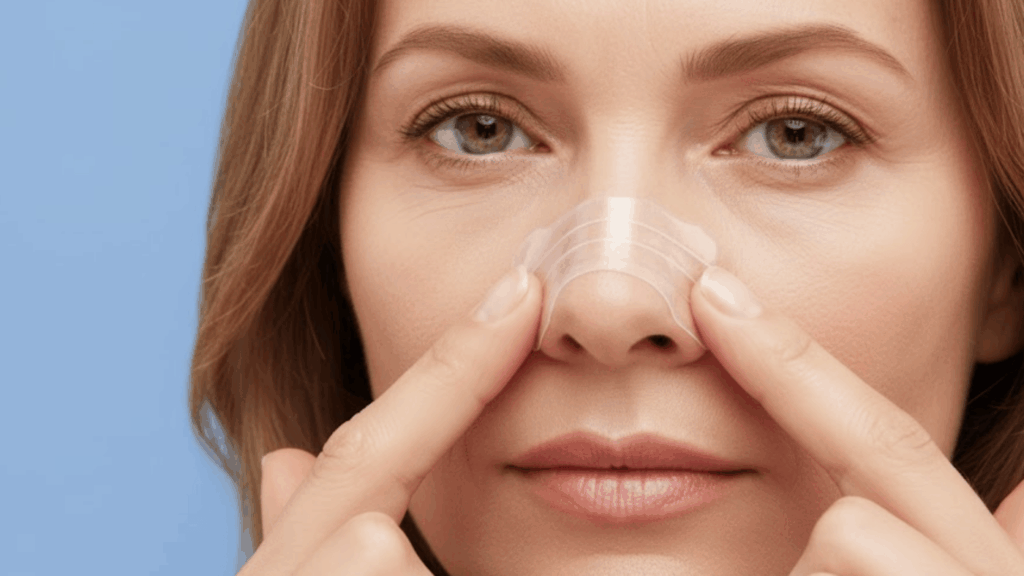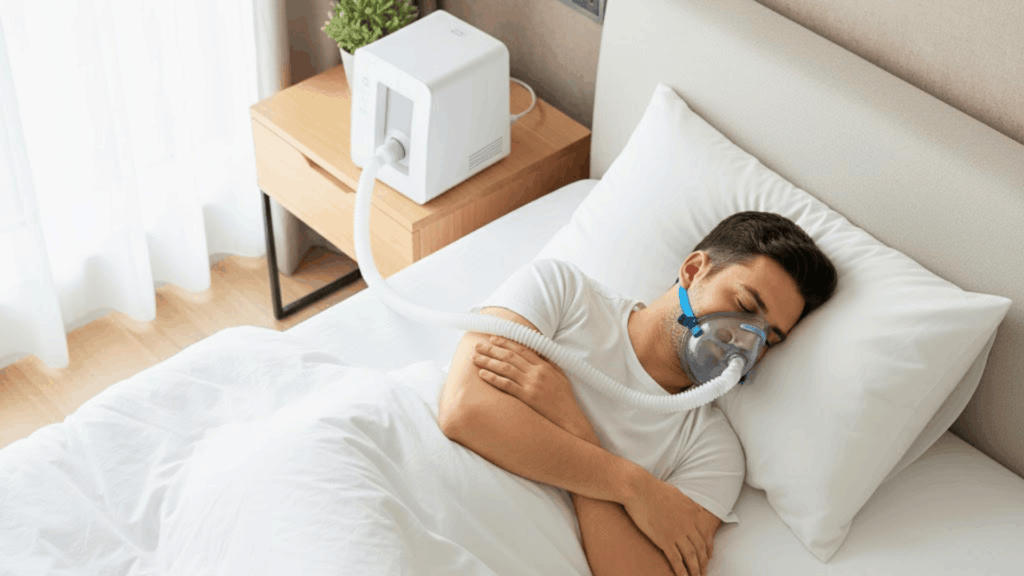Have you ever had someone tell you that you snore too loudly, or maybe you’ve noticed it’s hard to breathe clearly through your nose at night? I’ve been there too, and that’s when I learned about nasal strips.
These tiny adhesive bands might look simple, but they can make a big difference in how well you breathe and sleep.
In this blog, I’ll share what nasal strips do, how they work, when they help with snoring and congestion, and who should try them.
We’ll also talk about their benefits, how to use them correctly, and when it might be time to see a doctor.
What Do Nasal Strips Do?
Nasal strips are flexible adhesive bands placed across the bridge of the nose. Their main job is to gently lift the sides of the nose to create more airflow.
When the nasal passages are narrow due to a cold, allergies, or natural anatomy, breathing becomes harder. These strips help open things up.
In short, nasal strips:
- Widen the nasal passages for better airflow
- Reduce nasal congestion caused by allergies, colds, or sinus issues
- Help reduce mild snoring by improving airflow
- Provide temporary relief—they don’t fix structural issues permanently
They’re completely drug-free, which makes them a safe option for most people.
How Do Nasal Strips Work?

Think of a nasal strip as a tiny spring that sits on your nose. Once it sticks to the skin, it gently pulls up the nostrils and sides of the nose. This action creates a wider passage for air to move in and out.
Here’s how it works:
1. The Strip Is Placed Across the Bridge of the Nose
When a nasal strip is applied across the bridge of the nose, it sticks firmly to the skin using a gentle adhesive. This placement keeps the strip secure all night, preventing it from slipping off.
Proper placement ensures the strip effectively supports and lifts the nasal area, maximizing airflow improvement.
2. The Spring-Like Bands Lift the Nasal Cartilage
Inside each strip are flexible, spring-like bands that activate once applied. These bands gently lift the sides of the nose and the nasal cartilage upward.
This simple lift widens the nostrils slightly, allowing air to pass more easily and reducing the feeling of nasal blockage or stuffiness.
3. More Air Can Move Through the Nasal Passages
By widening the nasal openings, the strips allow a smoother flow of air through the nose. This extra space helps reduce airflow resistance and can make breathing feel more natural, especially during sleep.
People with mild congestion or narrow nasal passages often notice immediate improvement in breathing comfort.
4. Reduced Resistance and Vibration
With improved airflow, there’s less vibration in the tissues of the nose and throat, one of the main causes of snoring. This reduction can lead to quieter sleep and fewer disturbances at night.
The easier breathing also helps reduce morning dryness and fatigue, allowing for a more restful night overall.
The design is simple but smart. By lifting the nasal tissue, the strip helps prevent the collapse of nostrils during breathing, especially while sleeping.
Do Nose Strips Work for Snoring?
This is the question most people have: do nose strips work for snoring? The answer is yes, but with limits.
Nasal strips can help reduce mild or occasional snoring, especially when it’s caused by a blocked or stuffy nose. When air moves freely, there’s less vibration in the soft tissues of the throat, the main cause of snoring.
However, nasal strips may not be effective for everyone. If snoring is caused by conditions such as sleep apnea, obesity, or a collapsed throat, these strips won’t solve the problem.
| When Nasal Strips May Help | When They May Not Help |
|---|---|
| Snoring due to nasal congestion | Snoring caused by the throat or tongue |
| Mild snoring without sleep apnea | Obstructive sleep apnea |
| Temporary stuffiness from allergies or a cold | A severely deviated septum or nasal polyps |
| Situations where the nasal passages feel narrow | Chronic nasal or throat blockages that require medical treatment |
A review published in JAMA Facial Plastic Surgery found that nasal strips like Breathe Right can reduce nasal obstruction and mild snoring in some adults. But the results were mixed; some people noticed big improvements, while others barely felt a difference.
Benefits of Nasal Strips
Nasal strips are popular for good reason. They’re safe, easy to use, and can offer instant relief for those who struggle with nasal congestion or mild snoring.
Here are the key benefits:
- Better Airflow: Opens up the nostrils wider, allowing smoother airflow through the nasal passages for easier and more comfortable breathing every night.
- Less Snoring: Reduces vibrations in the nasal and throat tissues, helping to minimize snoring sounds and promote quieter, more peaceful sleep.
- Drug-Free Solution: Provides a natural, non-medicated way to relieve nasal congestion and improve airflow, making it ideal for sensitive or health-conscious users.
- Comfortable Sleep: Enhances nighttime breathing by keeping nasal passages open, resulting in deeper, more restful, and uninterrupted sleep quality.
- Good for Athletes: Helps athletes improve airflow during workouts or intense training sessions, promoting better oxygen intake and overall performance levels.
- No Invasive Devices: Works externally on the surface of the nose, offering effective results without the need for internal or surgical devices.
And the best part? They’re simple to use, just peel, stick, and breathe easier.
How to Use Nasal Strips the Right Way

Applying nasal strips correctly makes all the difference. Follow these simple steps:
- Step 1: Clean and dry your nose thoroughly with mild soap and water to remove oils, dirt, and any lingering surface moisture.
- Step 2: Gently peel off the adhesive backing from the nasal strip, being careful not to touch the sticky side to maintain strength.
- Step 3: Align and place the strip evenly across the bridge of your nose, right above the nostrils, ensuring proper balance and placement.
- Step 4: Press down firmly on both ends of the strip for several seconds to secure it tightly and enhance adhesive contact.
- Step 5: In the morning, slowly lift and loosen the edges before gently peeling off the strip to avoid irritation.
For best results, always apply a fresh strip nightly and select the size that best matches your unique nose shape.
Nasal Strips vs. Other Options
While nasal strips are great for quick relief, they’re not the only option for better breathing. Some people may need something stronger or longer-lasting.
| Options | Description | Effectiveness | Best For |
|---|---|---|---|
| Nasal Strips | Adhesive bands that lift the nostrils | Good for mild congestion | Occasional snorers |
| Internal Nasal Dilators | Small plugs are inserted inside the nostrils | Slightly stronger airflow | Moderate congestion |
| Vivaer Nasal Airway Remodeling | Non-surgical reshaping of nasal passages | Long-term solution | Chronic nasal blockage |
| CPAP Machine | Air pressure device for sleep apnea | Very effective | Sleep apnea patients |
| ENT Surgery | Fixes structural nasal issues | Permanent fix | Severe obstructions |
If nasal strips help a little but not enough, internal nasal dilators or a consultation with an ENT doctor may be the next step.
Side Effects and Safety of Nasal Strips
Nasal strips are safe for most people, but there are a few things to keep in mind.
Possible Side Effects:
-
Skin irritation or redness: Especially if removed roughly
-
Allergic reaction: Some adhesives can cause mild itching or rash
-
Temporary solution: Works only while the strip is on
To avoid issues:
-
Clean and dry the nose before applying
-
Don’t reuse strips
-
Use gentle removal after sleep
Overall, they’re much safer than medications or invasive treatments, making them a good first step for trying to improve breathing.
Who Should Try Nasal Strips?
Nasal strips can work wonders for the right person. Here’s who should consider using them:
- Mild snorers: People whose snoring is caused by nasal blockage
- Those with allergies or colds: Great for short-term congestion relief
- Athletes: Can use them during training for better airflow
- People avoiding medication: Offers a drug-free option
- Anyone seeking a simple fix: Easy to use at home without side effects
However, if snoring is accompanied by gasping, choking, or pauses in breathing, it’s important to speak to a healthcare provider, as those may be signs of sleep apnea.
Nasal Strips and Deviated Septum
A deviated septum means the thin wall between the nostrils leans to one side, making one nasal passage smaller.
Nasal strips can’t fix the structure itself, but they can temporarily relieve symptoms by widening the narrower side and allowing more air to pass through.
For a permanent solution, an ENT specialist might suggest a surgical procedure (septoplasty) or newer, non-surgical treatments like Vivaer Nasal Airway Remodeling.
When to See a Doctor
Sometimes, nasal strips are only part of the picture. If symptoms continue, professional advice is the best next step.
It’s Time to Consult a Doctor if:
- Snoring happens every night
- Breathing stops or gasping occurs during sleep
- There’s daytime fatigue or headaches
- Nasal congestion never fully clears up
Doctors may recommend a sleep study to check for sleep apnea or other breathing disorders. Depending on the cause, treatments such as CPAP, oral appliances, or minor nasal procedures may completely eliminate snoring.
Final Thoughts
After learning all about nasal strips, I can say they’re a simple but helpful tool for anyone who wants to breathe easier and sleep better.
They might not solve every snoring or congestion problem, but they’re an easy first step before trying more advanced treatments. I like that they’re drug-free, affordable, and safe for daily use.
If you’ve been struggling with stuffy nights or mild snoring, give nasal strips a try, you might be surprised by how much difference such a small strip can make. And if things don’t improve, it’s always best to talk to a doctor for more options.
Ready to sleep quietly and breathe freely tonight? Try a nasal strip and see how it feels!









